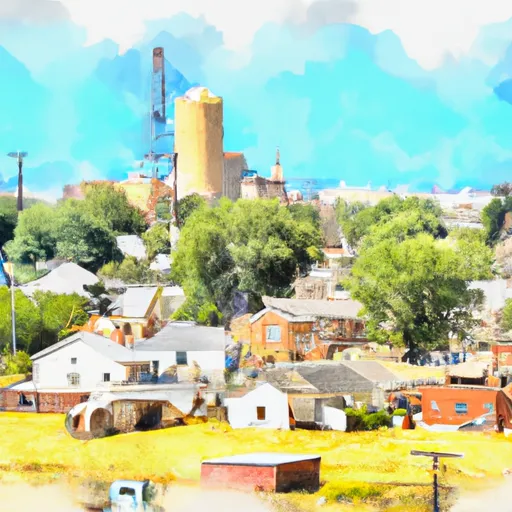-
 Snoflo Premium
Snoflo Premium
Get unlimited access to all our content
With no Ad interruptions! - Start Your Free Trial Login with existing account
Neal
Eden Index
Climate
8.3
•
Recreation
4.2
•
Community
•
Safeguard
4.8/10

Neal, Kansas is a small town located in the northeastern part of the state. It experiences a humid continental climate with hot summers and cold winters. Summers are generally warm with temperatures ranging from the mid-80s to high 90s°F, while winters are cold with temperatures dropping to the low 20s°F. Precipitation is evenly distributed throughout the year, with an average annual rainfall of 39 inches and snowfall of 15 inches.
The hydrology of Neal, Kansas is characterized by the presence of several small rivers and creeks, including the nearby Blue River and Little Blue River. These water bodies contribute to the region's hydrological system and provide habitat for various aquatic species.
Outdoor recreation opportunities in Neal, Kansas are plentiful. The region is known for its natural beauty, offering activities such as hiking, camping, fishing, and hunting. The surrounding area features numerous parks, trails, and wildlife areas where visitors can explore and enjoy the outdoors. Some popular destinations include the Blue River Rail Trail, Blue River Valley Park, and Tuttle Creek State Park, which offer opportunities for boating, swimming, and picnicking. Whether it's enjoying nature or engaging in recreational activities, Neal, Kansas provides diverse options for outdoor enthusiasts.
What is the Eden Index?
The Snoflo Eden Index serves as a comprehensive rating system for regions, evaluating their desirability through a holistic assessment of climate health, outdoor recreation opportunities, and natural disaster risk, acknowledging the profound impact of these factors on livability and well-being.
Climate Health Indicator (CHI): 8.3
Neal receives approximately
969mm of rain per year,
with humidity levels near 84%
and air temperatures averaging around
14°C.
Neal has a plant hardyness factor of
6, meaning
plants and agriculture in this region thrive during a short period during spring and early summer. Most
plants will die off during the colder winter months.
By considering the ideal temperature range, reliable water supplies, clean air, and stable seasonal rain or snowpacks, the Climate Health Indicator (CHI) underscores the significance of a healthy climate as the foundation for quality living.
A healthy climate is paramount for ensuring a high quality of life and livability in a region, fostering both physical well-being and environmental harmony. This can be characterized by ideal temperatures, reliable access to water supplies, clean air, and consistent seasonal rain or snowpacks.
Weather Forecast
Streamflow Conditions
Verdigris
Area Rivers
Verdigris
Snowpack Depths
Verdigris
Reservoir Storage Capacity
Verdigris
Groundwater Levels
Recreational Opportunity Index (ROI): 4.2
The Recreational Opportunity Index (ROI) recognizes the value of outdoor recreational options, such as parks, hiking trails, camping sites, and fishing spots, while acknowledging that climate plays a pivotal role in ensuring the comfort and consistency of these experiences.
Access to outdoor recreational opportunities, encompassing activities such as parks, hiking, camping, and fishing, is crucial for overall well-being, and the climate plays a pivotal role in enabling and enhancing these experiences, ensuring that individuals can engage in nature-based activities comfortably and consistently.
Camping Areas
| Campground | Campsites | Reservations | Toilets | Showers | Elevation |
|---|---|---|---|---|---|
| Sedan City Park | 15 | 843 ft | |||
| Rock Ridge Cove North - Fall River Lake | 45 | 973 ft | |||
| Sun Dance - Melvern Lake | None | 1,079 ft | |||
| Wah - Sha - She State Park | None | 771 ft | |||
| Washington Cove - Copan Lake | None | 745 ft | |||
| Johnstone Park | 6 | 670 ft | |||
| Post Oak Park - Copan Lake | None | 749 ft | |||
| Osage Hills State Park | None | 785 ft | |||
| Caney Bend | 5 | 800 ft | |||
| Fall River State Park | 165 | 995 ft |
Nearby Fishing
Catastrophe Safeguard Index (CSI):
The Catastrophe Safeguard Index (CSI) recognizes that natural disaster risk, encompassing floods, fires, hurricanes, and tornadoes, can drastically affect safety and the overall appeal of an area.
The level of natural disaster risk in a region significantly affects safety and the overall livability, with climate change amplifying these risks by potentially increasing the frequency and intensity of events like floods, fires, hurricanes, and tornadoes, thereby posing substantial challenges to community resilience and well-being.
Community Resilience Indicator (CRI):
The Community Resilience Indicator (CRI) recognizes that education, healthcare, and socioeconomics are crucial to the well-being of a region. The CRI acknowledges the profound impact of these elements on residents' overall quality of life. By evaluating educational resources, healthcare accessibility, and economic inclusivity, the index captures the essential aspects that contribute to a thriving community, fostering resident satisfaction, equity, and social cohesion.

